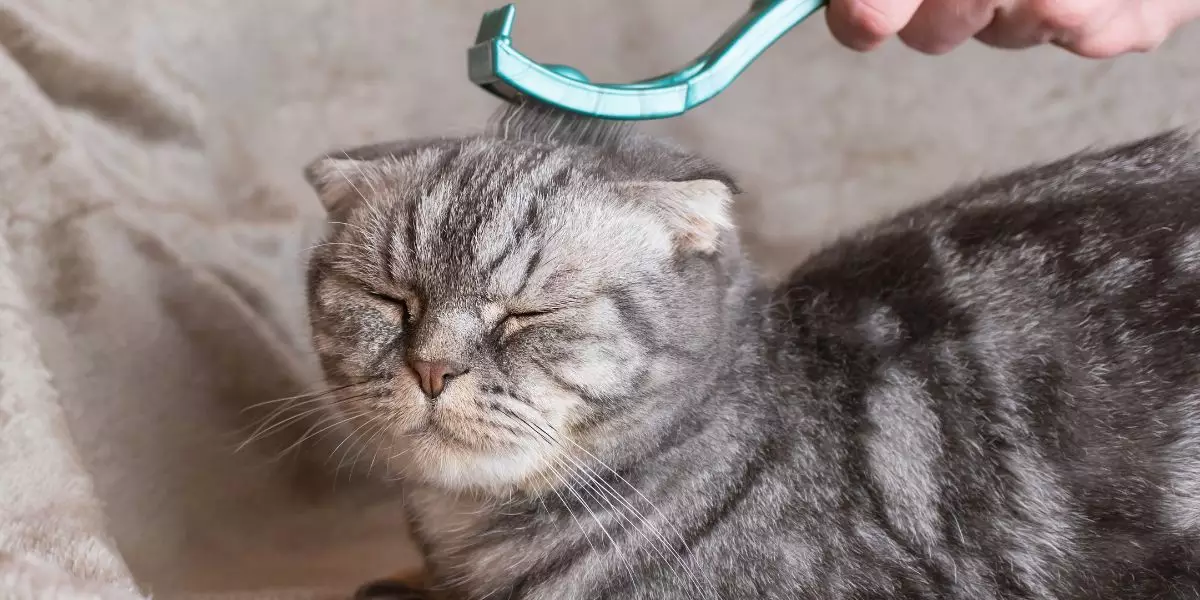Hair loss in cats is a common problem that can cause discomfort and anxiety in cat owners. Cats have a natural moulting cycle that can result in temporary hair loss, but the excessive hair loss can be caused by a variety of factors, ranging from external parasites to internal diseases. It is important to understand the possible causes of hair loss in cats in order to quickly identify and treat any underlying health problems.
In this article, we will explore the different causes of hair loss in cats, as well as the available treatment options to help solve this problem and maintain a beautiful fur for your cat.
Table of Contents
ToggleWhy is my cat losing her hair?
There are many potential causes of hair loss in cats. Common causes include pests such as fleas and ticks, skin diseases such as eczema, food or environmental allergies, stress, seasonal moulting, and certain hormonal disorders. It is also possible that hair loss is a side effect of drug treatment.
Seasonal moulting
Seasonal moulting is a natural phenomenon in cats, usually occurring in spring and autumn when temperatures begin to change. During this period, cats lose a lot of hair, often more than usual.
This phenomenon is related to the production of hormones in the cat's body, which is influenced by the length of the day and sunlight. Cats have light-sensitive receptors that detect light changes and trigger the production of hormones that control hair growth.
During seasonal moulting, older hairs are replaced by new, thicker and more resistant hairs adapted to temperature changes. This is why cats tend to lose more hair during cooler months, in autumn, and less during warmer months, in summer.
It is important to note that not all cats follow exactly the same schedule for seasonal moulting, and some cats may lose hair throughout the year.
The Stress
Stress can be an important factor in hair loss in cats. When cats are stressed, their bodies release stress hormones which can cause hormonal disturbances and changes in hair growth.
There is different reasons for which cats can be stressed, such as:
-
- A change in their environment, like moving to a new home
-
- The presence of another animal or a newcomer in the house
-
- Diseases that cause pain or discomfort
-
- Lack of attention or company
Parasites
The external pests such as fleas and ticks can cause hair loss in cats, in addition to itching and irritation. Cats will tend to scratch and lick frequently because of the discomfort, which can cause hair loss and skin lesions.
Cats can also be infected with internal mites, such as Demodex, which can cause skin problems and hair loss. It is important to regularly protect your cat from pests using appropriate pest control products.
Vers Complex
A mixture of plants traditionally used against pests. ✅Promotes the evacuation of internal parasites ✅Helps to regain digestive comfort Format: 100g Dose spoon included
Allergies
Allergies may cause hair loss in cats, in addition to causing itching, irritation and skin lesions. Cats can be allergic to many elements of their environment, such as mites, pollen, mould, food and even animal care products.
Food allergies are one of the most common causes of skin irritation and hair loss in cats. Cats can be allergic to any protein or ingredient in their food, such as meat, fish, eggs or cereals.
It is difficult to determine whether a cat is allergic to something without a professional diagnosis. If you suspect that your cat is allergic to an element present in its environment or food, it is important to consult a veterinarian to obtain an appropriate diagnosis and treatment.
Hormonal Disequilibrium
One hormonal imbalance may cause hair loss in cats, in addition to causing other symptoms such as changes in hair growth, skin problems, changes in appetite and mood. Cats can be affected by hormonal imbalances for various reasons, such as endocrine tumours.
The Pelade
The pelade is a skin disease which is characterized by degarned areas or bare skin plates. It can be caused by a variety of factors, including fungal or bacterial infections, allergies, hormonal problems or autoimmune conditions.
Cats can actually develop pelade, although this is quite rare. The most common causes of pelade in cats are allergies, fungal disorders, hormonal disorders, and parasitic infections. Cats can also develop pelade due to emotional stress or age-related skin disorders.
The symptoms of pelade in cats may include itching, redness, squamousness, hair loss, and wounds or crusts on the skin. If you notice these symptoms in your cat, it is important to consult a veterinarian for appropriate diagnosis and treatment.
The Teat of the Cat
The moth is a fungal skin condition which is caused by a species of fungus called Microsporum canis. Cats are one of the main hosts of this fungus, although dogs and humans may also be infected.
The symptoms of moth in cats usually include areas of red and swollen skin, with patches or patches of sparse or fallen hair. Cats may also experience itching and pain in affected areas, and may scratch or lick the affected skin excessively.
Treatment of moth in cats generally consists of using topical or oral antifungal drugs to kill the fungus, accompanied by local attention to maintain skin hygiene and prevent reinfections. Moth cats should be treated until they are fully cured, usually 4 to 6 weeks, and all objects that have been in contact with the infected animal should be carefully cleaned and disinfected to avoid reinfection.
It is important to note that moth is contagious and can be transmitted to other animals and humans, so it is important to follow your veterinarian's recommendations to avoid any transmission.
Is it dangerous?
The hair loss in cats may be caused by different factors. It is important to consult a veterinarian to determine the cause of hair loss in your cat in order to treat it effectively.
Hair loss in cats may be caused by natural causes such as seasonal moulting or age-related hair loss. However, it can also be caused by health problems such as fungal or bacterial infections, parasitism, allergies, stress, hormonal disorders or skin diseases.
How can this be addressed?
It is important to consult a veterinarian for determine the cause of hair loss in your cat before taking action to remedy it. Once the cause of hair loss has been established, the veterinarian may recommend appropriate treatment.
Here some general steps which can help to remedy hair loss in cats:
-
- Medical treatment : If hair loss is caused by fungal or bacterial infection, parasitism, skin disease or hormonal disorder, medical treatment will be required. The veterinarian may prescribe appropriate medicines to treat these conditions.
-
- Changes in diet : If hair loss is caused by food allergy, it may be necessary to change your cat's diet. It is important to consult a veterinarian before changing your cat's food.
-
- Environmental change : If hair loss is caused by stress, it is important to reduce the sources of stress in your cat's environment, such as loud noises or the presence of other animals. It is also important to provide your cat with safe rest and play areas.
-
- Skin care : it is important to maintain a good level of hygiene by taking care of the skin and hairs of your cat. This may include regular brushing to remove dead hair and knots, as well as baths to nourish and moisturize the skin.






